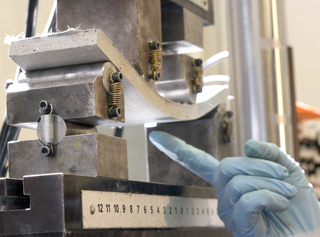|
Subscribe / Renew |
|
|
Contact Us |
|
| ► Subscribe to our Free Weekly Newsletter | |
| home | Welcome, sign in or click here to subscribe. | login |
Construction
| |
 |
April 30, 2010
Self-healing concrete could make repairs a thing of the past
University of Michigan

Li
|
Imagine bridges and roadways that never need repair. No construction zones, no traffic jams and no detours due to reconstruction activities.
This may happen sooner than you think, with concrete that repairs itself when damaged.
It works like our body. If we have a paper cut on our fingers, we expect it to heal itself. A major chain saw accident would land us in a hospital. We cannot expect self-healing when the damage is catastrophic. So it seems logical that concrete that has the ability to limit its damage to hairline cracks could heal itself.
A new concrete material developed at the University of Michigan will do just that. A cousin of the bendable concrete developed in the same laboratory, the self-healing version keeps its cracks tight to about 30 microns, less than a third of the width of a human hair. These small cracks then form a white scar as they heal, requiring only water and air.
Good as new
Cracks in today’s concrete are often a millimeter to a centimeter in width, as often seen on bridge decks and pavements. Cracks form for a number of reasons, including drying that causes concrete to shrink and pull away from restraints, and regular wear and tear due to traffic loads. Even with steel reinforcements, there is at present no reliable means to control crack width in concrete structures.
In self-healing bendable concrete, the tiny cracks seal themselves with chemical products such as calcite, a material similar to abalone shells, when dry cement grains come into contact with rain and carbon dioxide in the air.
Calcite is weak and would easily pop off. In self-healing bendable concrete endowed with plenty of dry cement, the calcite crystals arrange themselves around microfibers inside the concrete, and become self-reinforced as they are formed. So they can become as strong as the original concrete.
Laboratory tests show that the weakened, microcrack-damaged concrete recovers its strength after self-healing. Upon reloading, the well-healed material shows the same stiffness as if it has never been damaged.
Unlike regular concrete, bendable concrete has the ability to give rather than fracture when overloaded. In this way, it behaves more like malleable steel and less like brittle glass. A bendable concrete specimen can stretch several hundred times compared with regular concrete before it finally gives up and breaks into two parts.
As it stretches, the opening of microcracks provides the give, like an accordion being pulled. And then these microcracks disappear after a couple of drizzles of rain.
The small cracks are helpful in preventing water and deicing salts from getting into the steel rebars, which could corrode. Rebar corrosion is a major deterioration mechanism in bridge decks in the northern states that use deicing salts to clear the roadways after snow falls.
As the small cracks reheal themselves, this further prevents the ingress of corrosives into the bridge deck from ponding water laden with salt. Just as self-healing of a paper cut on our fingers helps prevent inflammation and keeps us healthy, self-healing of microcracks in bridge decks help prevent steel corrosion and concrete spalling and keep the bridge deck in good condition.
No construction zones, no traffic jams and no detours. This is good news to motorists and DOTs alike, as self-healing concrete translates into time and money savings.
Not just for roads
Apart from bridge decks and highway pavements, self-healing bendable concrete can also be used in concrete products such as building elements that last. In underground structures such as tunnels, where ground movements often cause concrete walls to crack and water seepage becomes a problem, self-healing concrete simply seals itself off, taking advantage of the available seepage water to do the healing.
Carbon dioxide from automobile exhaust in tunnels would accelerate the healing. Similarly, leak-proof water tanks and other containers or linings that need to be watertight may find self-healing concrete useful.
Self-healing concrete has many interesting and useful characteristics. The healing occurs when and where it is needed. Healing is available anywhere the concrete structure is damaged. The healing mechanism has a long shelf life, giving the structure a lifetime guarantee of sorts.
The product will most likely be available for commercial use within a couple of years. It can be produced using methods similar to the existing methods for making concrete, and with the same equipment. The cost will be higher than conventional concrete initially, but it’s expected to go down once it’s in wider use.
Research is ongoing to ensure the healing will happen not just once, but multiple times if damage is repeated. And research is ongoing to make rehealing fast. Just like what we want with our body’s self-healing capability.
Victor Li is the E.B. Wylie collegiate chair professor in the Department of Civil and Environmental Engineering at the University of Michigan.
Other Stories:



